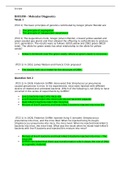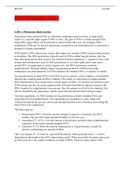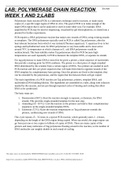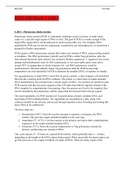Bios 390 week 1 lab 1 Samenvattingen, Aantekeningen en Examens
Op zoek naar een samenvatting over Bios 390 week 1 lab 1? Op deze pagina vind je 40 samenvattingen over Bios 390 week 1 lab 1.
Pagina 3 van de 40 resultaten
Sorteer op
BIOS 390 Molecular Biology Week 1-7 Exam Study Guide with Lab Reports- Complete Guide (Download to score an A) 2021
BIOS 390 Week 1 LAB 1
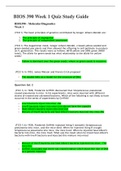
-
BIOS 390 Week 1 Quiz Study Guide (LATEST UPDATE) | Download To Score An A
- Tentamen (uitwerkingen) • 11 pagina's • 2022
-
- $10.99
- + meer info
BIOS 390 Week 1 Quiz Study Guide BIOS390 – Molecular Diagnostics Week 1 (TCO 1) The basic principles of genetics contributed by Gregor Johann Mendel are: 1. The principle of segregation 2. T he principle of independent assortment (TCO 1) The Augustinian monk, Gregor Johann Mendel, crossed yellow-seeded and green-seeded pea plants and then allowed the offspring to self-pollinate to produce an F2 generation. The results were as follows: 6018 yellow and 2002 green (8020 total). The allele for gre...
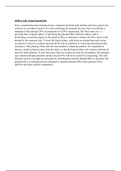
-
BIOS 390 Molecular Biology With Lab-Devry Latest Update 2023/2024
- Voordeelbundel • 8 items • 2020
-
- $15.49
- + meer info
BIOS 390 Week 1 LAB 1: Polymerase Chain Reaction BIOS 390 Week 1 Quiz Study Guid BIOS 390 Week 2 LAB 2: Gel Electrophoresis BIOS 390 Week 2 Quiz Study Guide BIOS 390 Week 3 LAB: DNA Cloning BIOS 390 Week 4 LAB: Gene expression BIOS 390 Week 5 LAB: Transcription in Prokaryotes-Verified BIOS 390 Week 6 LAB: Isolate Plasmid DNA-Verified
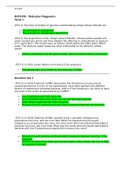
-
BIOS 390 Molecular Biology Week 1-7 Exam Study Guide with Lab Reports- Complete Guide
- Tentamen (uitwerkingen) • 47 pagina's • 2022
-
- $16.49
- + meer info
BIOS390 – Molecular Diagnostics Week 1 (TCO 1) The basic principles of genetics contributed by Gregor Johann Mendel are: 1. The principle of segregation 2. The principle of independent assortment (TCO 1) The Augustinian monk, Gregor Johann Mendel, crossed yellow-seeded and green-seeded pea plants and then allowed the offspring to self-pollinate to produce an F2 generation. The results were as follows: 6018 yellow and 2002 green (8020 total). The allele for green seeds has what relati...
BIOS 390 Week 1, 2 LAB 1
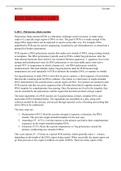
-
BIOS 390 Week 1 LAB 1
- Case uitwerking • 4 pagina's • 2021
-
- $10.00
- + meer info
BIOS 390 Week 1 LAB 1 LAB 1: Polymerase chain reaction Polymerase chain reaction (PCR) is a laboratory technique used to increase, or make many copies of, a specific target region of DNA in vitro. The goal of PCR is to make enough of the target DNA region that it can be analyzed or used in some other way. For example, DNA amplified by PCR may be sent for sequencing, visualized by gel electrophoresis, or cloned into a plasmid for further experiments. PCR requires a DNA polymerase enzyme tha...
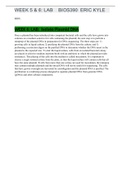
-
BIOS 390 WEEK 6: LAB: isolate Plasmid DNA
- Tentamen (uitwerkingen) • 1 pagina's • 2022
-
- Gratis
- + meer info
BIOS 390 WEEK 6: LAB: isolate Plasmid DNABIOS 390 BIOS . BIOS 390 WEEK 6: LAB: isolate Plasmid DNA Once a plasmid has been introduced into competent bacterial cells and the cells have grown into colonies on a medium selective for cells containing the plasmid, the next step is to perform a miniprep of the plasmid DNA in preparation for DNA sequencing. The three steps are: 1) growing cells in liquid culture; 2) purifying the plasmid DNA from the culture; and 3) performing a restriction diges...

-
BIOS 390 Week 6 LAB: Isolate Plasmid DNA-Verified
- Case uitwerking • 1 pagina's • 2020
- Ook in voordeelbundel
-
- $8.49
- + meer info
BIOS 390 Week 6 LAB: Isolate Plasmid DNA-Once a plasmid has … introduced into competent bacterial cells and the cells have grown into colonies on a medium selective for cells containing the plasmid, the next step is to perform a miniprep of the plasmid DNA in preparation for DNA sequencing. The three steps are: 1) growing cells in liquid culture; 2) purifying the plasmid DNA from the culture; and 3) performing a restriction digest on the purified DNA to determine whether the DNA insert in the ...
BIOS 390 Week 1 LAB 1

Hoe heeft hij dat gedaan? Door zijn samenvatting te verkopen op Stuvia. Probeer het zelf eens! Ontdek alles over verdienen op Stuvia

